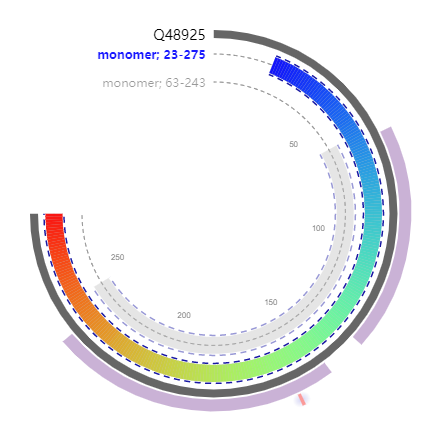Harbors a corrinoid prosthetic group and acts as a methyl group carrier in methanogenesis from methylated-thiols.
MIRHIDLAVQNILEMKEKEPAKFKRLIDEGIMIGLGVDLEDGNKEVTTVDQIKNQNRPKD
PEYASVAEAVIEGNNAETVKLISALLEKGKDPTDLVLNALMPGIQTVCELYDIGESYVPE
ILLANEALMKGVELCQKKKGEVPSQGKVVSLVIVGDLHDIGKNIVAAILRANGFEVIDLG
RDVTVEAAVEAVKSTKANLVTGTTLMSTTKGGLKALANALEPEGVPLACGGAAVDRRFVD
TFGNSVYGRTPLDAVKIAKEICEGKSWEEARNELY279

| PMID | Title & Author | Abstract | Year | |
| 0 | 29283203 | Synthesis, Structure, and Cytotoxicity of a New Sulphanyl-Bridged Thiadiazolyl-Saccharinate Conjugate: The Relevance of S⋅⋅⋅N Interaction. Lília I L Cabral , Elisa M Brás , Marta S C Henriques , Catia Marques , Luís M T Frija , Luísa Barreira , José António Paixão , Rui Fausto , Maria Lurdes S Cristiano | Reports showing that the copper concentration is considerably higher in neoplasms than in normal tissues prompted the need to develop selective copper chelators. We disclosed recently that some N-linked tetrazole-saccharinates bind selectively to copper, forming complexes that are highly cytotoxic towards cancer cells. Because tetrazole-saccharinates are photolabile, due to the photoreactivity of tetrazoles, we proposed thiadiazolyl-saccharinates as an alternative. Herein we describe the synthesis, structure, and monomeric photochemistry of a sulphanyl-bridged thiadiazolyl-saccharinate, 3-[(5-methyl-1,3,4-thiadiazol-2-yl)sulphanyl]-1,2-benzothiazole 1,1-dioxide (MTSB). The monomeric structure, charge density analysis, and characteristic infrared spectrum of MTSB were investigated theoretically, using quantum chemical calculations, and also experimentally, using matrix-isolation infrared spectroscopy. The crystal structure was investigated by combining X-ray crystallography with infrared and Raman spectroscopies. Results show that the structure of isolated MTSB is similar to that found in the crystal, with an S⋅⋅⋅N interaction clearly contributing to the structure of the molecule and of the crystal. Matrix irradiation revealed a high photostability of MTSB, compared to parent tetrazole-saccharinates and to the 5-methyl-1,3,4-thiadiazole building block, emphasizing the photostabilizing effect of the saccharyl system. Finally, in vitro toxicity assays of MTSB showed a copper concentration-dependent toxicity against cancer cells, without affecting normal cells. In particular, MTSB was most effective towards the hepatic (HepG2), neuroblastoma (SH-SY5), and lymphoma cell lines (U937). Thus, MTSB represents a promising lead for cancer chemotherapy based on chelating agents. | 2018 |
| 1 | 11073950 | The MtsA subunit of the methylthiol:coenzyme M methyltransferase of Methanosarcina barkeri catalyses both half-reactions of corrinoid-dependent dimethylsulfide: coenzyme M methyl transfer. T C Tallant , L Paul, J A Krzycki | Methanogenesis from dimethylsulfide requires the intermediate methylation of coenzyme M. This reaction is catalyzed by a methylthiol:coenzyme M methyltransferase composed of two polypeptides, MtsA (a methylcobalamin:coenzyme M methyltransferase) and MtsB (homologous to a class of corrinoid proteins involved in methanogenesis). Recombinant MtsA was purified and found to be a homodimer that bound one zinc atom per polypeptide, but no corrinoid cofactor. MtsA is an active methylcobalamin:coenzyme M methyltransferase, but also methylates cob(I)alamin with dimethylsulfide, yielding equimolar methylcobalamin and methanethiol in an endergonic reaction with a K(eq) of 5 x 10(-)(4). MtsA and cob(I)alamin mediate dimethylsulfide:coenzyme M methyl transfer in the complete absence of MtsB. Dimethylsulfide inhibited methylcobalamin:coenzyme methyl transfer by MtsA. Inhibition by dimethylsulfide was mixed with respect to methylcobalamin, but competitive with coenzyme M. MtbA, a MtsA homolog participating in coenzyme M methylation with methylamines, was not inhibited by dimethylsulfide and did not catalyze detectable dimethylsulfide:cob(I)alamin methyl transfer. These results are most consistent with a model for the native methylthiol:coenzyme M methyltransferase in which MtsA mediates the methylation of corrinoid bound to MtsB with dimethylsulfide and subsequently demethylates MtsB-bound corrinoid with coenzyme M, possibly employing elements of the same methyltransferase active site for both reactions. | 2001 |
Tallant T C , Paul L , Krzycki J A . The MtsA Subunit of the Methylthiol:Coenzyme M Methyltransferase of Methanosarcina barkeri, Catalyses Both Half-reactions of Corrinoid-dependent Dimethylsulfide: Coenzyme M Methyl Transfer *[J]. Journal of Biological Chemistry, 2001, 276.